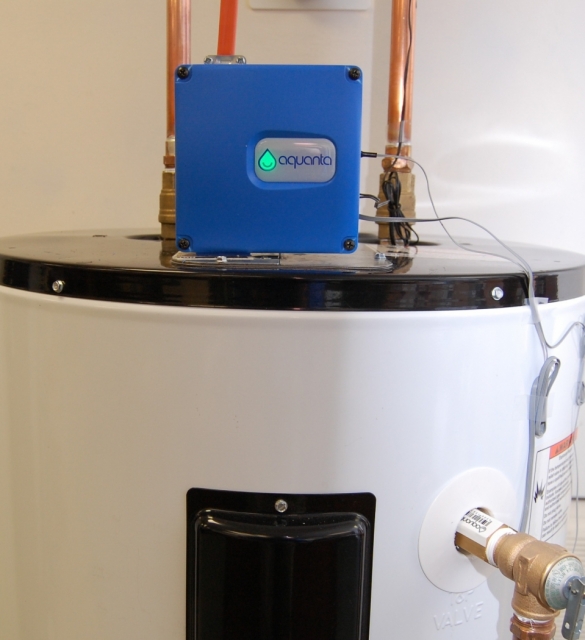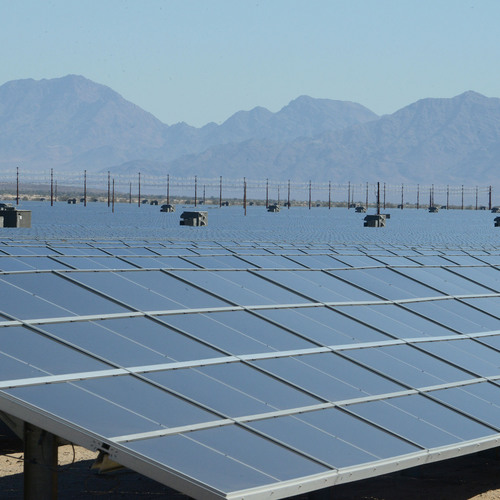
Image Credit: 10 10 / CC BY 2.0 / Flickr
Solar ownership growing
The number of homeowners opting to buy photovoltaic (PV) systems rather than lease them will increase to 45% this year as system components continue to get cheaper and low-cost financing becomes more available.
The country’s three big solar installers — SolarCity, Vivint Solar and Sunrun — have seen growth slowing down, and share prices have dropped more than 40% this year, according to an article posted at Bloomberg. Those companies built their success on solar leases that required no upfront payments from customers. Now, homeowners have access to loans that don’t require money down, and installers are among the lenders.
“Leasing was the major game, but that’s changing quickly,” Patrick Jobin, an analyst at Credit Suisse Group AG, told Bloomberg. “Consumers are starting to realize there are better options.”
The proportion of customers buying rather than leasing was 38% just two years ago, but by next year, owners will be in the majority.
They are people like Greg Gill, who decided to spend $32,370 to buy a 7.3-kW system last year for his California home after considering a lease. His utility bill went from $400 to $1.18 per month, while he earned a $10,000 tax credit, Bloomberg said. In addition, Gill earned reward points for using a credit card to make the purchase initially. Overall, he thinks his return on the investment will be 11%.
“It really was a no-brainer,” he said. “Even if you financed it at 3%, you still come out ahead over leasing.”
Sunrun Chairman Ed Fenster, however, expects leasing to regain an edge when the 30% federal income tax credit for solar expires in 2033.
Tougher greenhouse gas rules in New York
New York State lawmakers have introduced a bill that would phase out anthropogenic greenhouse gas emissions by 2050, a move that environmental advocates say will shift the state to 100% renewable energy.
UtilityDive says that the proposed legislation would reduce greenhouse gas emissions in steps, to 25% below 1990 levels by 2025, 50% below 1990 levels by 2030, and 80% by 2045. A complete phaseout would come in 2050.
Electric utilities would be required to source 30% of their power from renewable sources by 2020, 40% by 2025, and 50% by 2030. Although the legislation does not include a provision requiring 100% renewable energy, that’s how it will work out, says Peter Iwanowicz, executive director of Environmental Advocates of New York.
The legislation covers oil refineries and storage facilities, electric generating facilities of 25 megawatts or more that burn fossil fuels, any stationary source of greenhouse gas emissions that emit 25,000 tons or more per year of carbon dioxide, and “any other source” that can be measured and that the state deems a major contributor. It doesn’t specifically mention transportation or home heating.
Governor Andrew Cuomo proposed a non-binding plan last year to guide the state toward lower greenhouse gas emissions and a greater use of renewable energy, and New York regulators have been examining new business models for utilities through a proceeding called Reforming the Energy Vision, or REV.
Greenhouse gas emissions for 1990 have not yet been established, but a 2014 report said that pollution from the power sector was higher that year than it is today, UtilityDive said. So, if the bill were to pass, utilities would be required to completely eliminate greenhouse gases by the middle of the century.
The bill says that the reduction of greenhouse gases is essential to keeping carbon dioxide levels in the atmosphere to no more than 450 parts per million and limit the global temperature rise to 2 degrees Celsius or less.
“The severity of current climate change and the threat of additional and more severe change will be affected by the actions undertaken by New York and other jurisdictions to reduce greenhouse gas emissions,” the bill says.
Time lapse: A wind turbine in 1 minute
England’s Royal Society for the Protection of Birds (RSPB) recently installed a 100-meter tall wind turbine at its headquarters that is expected to generate enough electricity to cover about half the power used by all 127 RSPB locations in the country.
A video that accompanied the post at Clean Technica shows construction of the turbine compressed into just 70 seconds.
Bird conservation groups are frequent critics of wind turbines because of their impact on bird and bat populations, but the RSPB says that it has taken steps to mitigate the problem. The turbine, installed and financed by Ecotricity, has a “bat detection monitor.” The tubine can be switched off during the summer when wind speeds are low and at times of the day when bats are most likely to be nearby. Ecotricity said it was the first time those measures had been used in Britain to help protect bats.
RSPB is an advocate of renewable energy and says that climate change poses the greatest threat to wildlife.
New controller for water heaters
A Virginia-based company will begin deliveries later this year of a web-connected controller for water heaters that learns hot water use patterns and allows homeowners to manage water heaters via a smart phone or tablet.
The company compares the Aquanta to the Nest thermostat, which adapts to household routines to lower heating and cooling bills and can be managed with a wi-fi connection.

Aquanta says that the $149 device learns how homeowners use hot water and heats water accordingly. It has a dashboard showing hot water use and can indicate when supplies of hot water are low. It also can issue maintenance alerts.
The Aquanta, which will begin shipping in July, uses a sensor to measure the energy used to heat water. Software uses the data to learn and control water heating according to use patterns. It’s compatible with many types of electric and gas water heaters with electronic ignition controls, but it doesn’t work with indirect water heaters connected to a boiler or with tankless heaters.
Writing at Treehugger, Lloyd Alter says that the Aquanta can take advantage of time-of-day electricity costs, becoming a sort of “thermal battery” that heats water when electricity is cheap for use when it would be much more expensive. It’s also useful for lowering the risk of Legionnaire’s Disease by cycling water that’s hot enough to kill the Legionella bacteria.
In high-performance houses, Alter notes, energy costs for heating water are higher than for space heating, making efficient water heating very important.
Weekly Newsletter
Get building science and energy efficiency advice, plus special offers, in your inbox.















3 Comments
Aquanta claims
Aquanta claims in their FAQ:
"our data suggest that at least 20% and up to 50% of that energy in a typical home is wasted through "standby loss". We are being careful to not overpromise, and have 3rd party testing underway to more specifically quantify the saving opportunity. However, our internal studies and modeling suggest that between 10-30% of water heating energy can be saved by intelligent control through Aquanta."
This claim is grossly exaggerated. A good electric tank has an efficiency factor of 0.95, which, for electric, means 5% standby loss in typical use. Their low end number is 20%, so that's a 4x exaggeration. That is probably about right for most of their numbers. Divide by four to get more reasonable estimates.
I'm enthusiastic about Internet control of water heaters for demand response, but their emphasis on standby losses doesn't make sense unless it's a vacation cottage that unoccupied most of the time.
There is advantage to the legionella control
The energy savings claims are indeed excessive, but if pre-heating the tank to 160F+ just prior to heavy HW use one gains the sterilization benefit without the higher standby cost of idling the tank at such a high temp.
I'm not sure the sterilization benefit is "worth" the $149 over just idling it at 140F+, unless get real-time energy pricing is available from the utility, and get paid heat the water whenever the LMP drops below $0/Mwh.
Reply to Dana re logionella
Good point about the sterilization benefit. I'd pay 149 for that plus the ability to participate in a real time market ... But when my utility lets me sign up, that may require purchasing another interface box, even though I hope it will be available across many hardware systems.
Log in or create an account to post a comment.
Sign up Log in